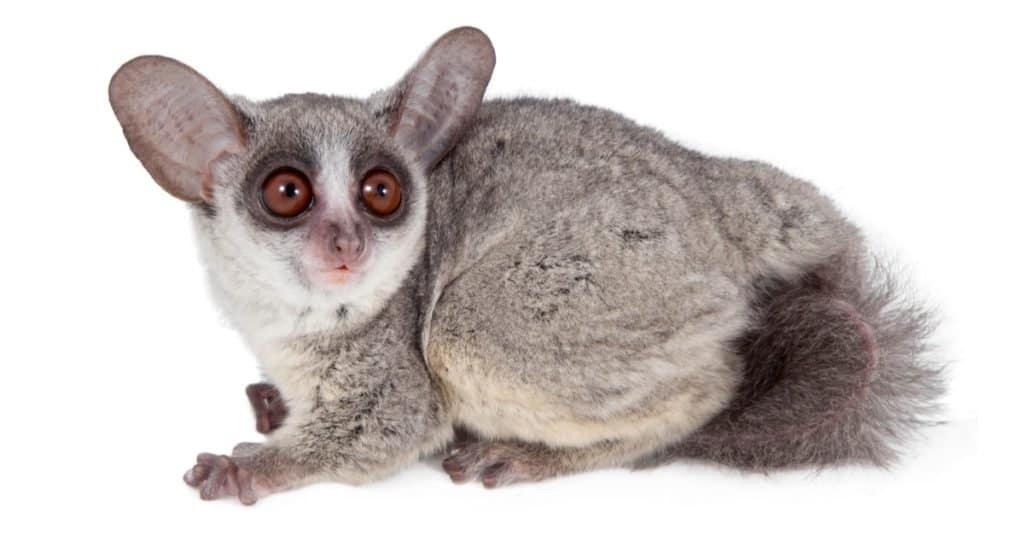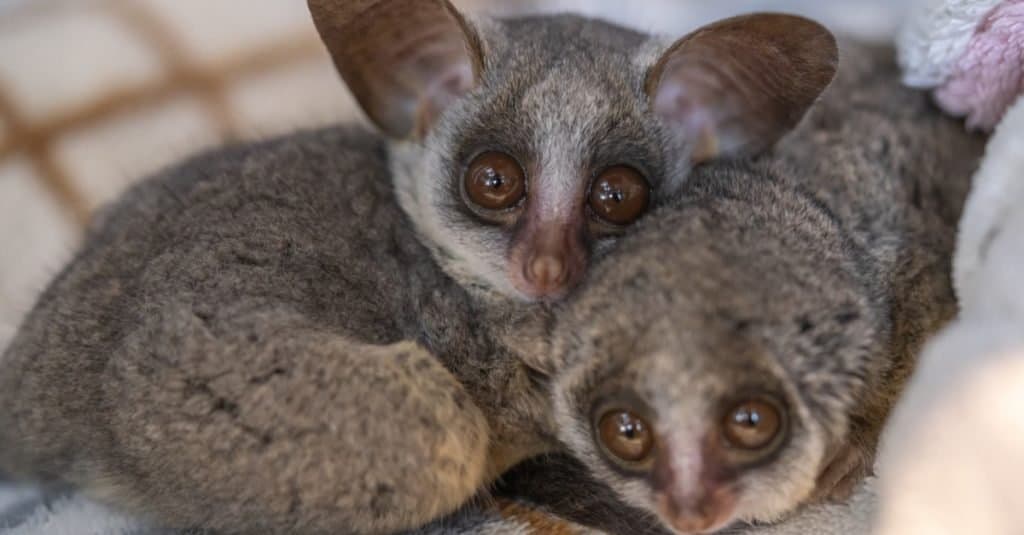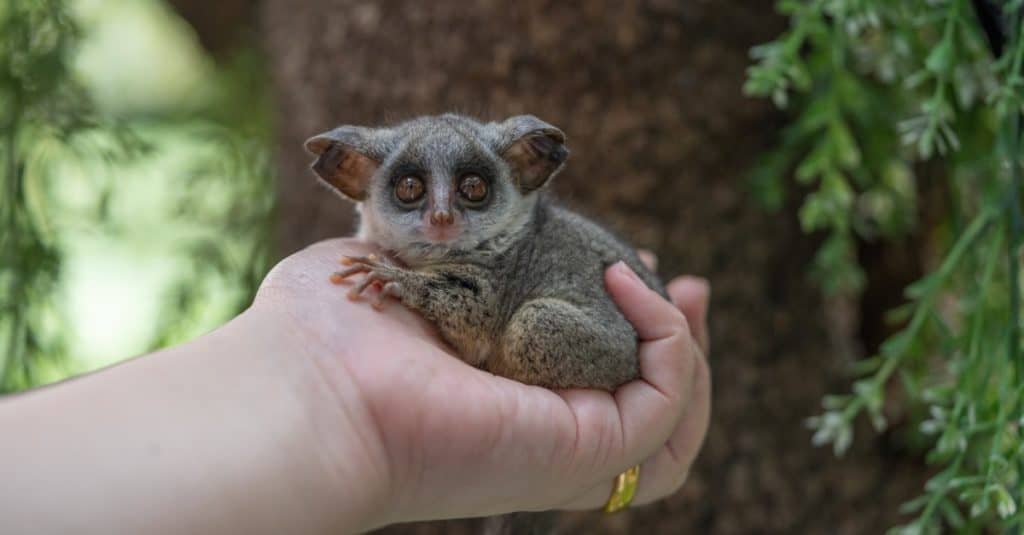If you love exotic pets, you may have wondered at some point if the adorably bizarre bushbaby pet, also known as the Galago, could be reasonably kept in captivity. After all, many exotic animals can make surprisingly good pets with the right kind of care.
The bush baby’s small size and cute appearance make it seem like it’d be a perfect pet and delightful companion!
However, things are not always as they seem, especially in the animal kingdom! Let’s take a look at the bushbaby pet and whether or not keeping it as a pet is an ethical, humane, and responsible choice.
What Are Bush Babies?

Bush babies are small primates native to
Africa
.
©Rosa Jay/Shutterstock.com
The bush baby has a few different common names. These include nagapy, meaning “night monkey” in Afrikaans, and galago, which refers to the animal’s taxonomical classification within the family Galagidae.
Despite resembling marsupials or rodents, bush babies are actually small primates. They are fairly closely related to other small primates like lorises and lemurs.
There are actually around 20 different species of bush babies! However, they are all quite similar in size, habitat, behavior, and appearance. Because bush babies are nocturnal and fairly reclusive, researchers believe there are still more species of this unique animal they have yet to discover.
A Bushbaby pet is small, lightweight body is perfectly suited to their nocturnal, highly arboreal lifestyle. They have large, round eyes that can see well in low-light conditions. They’re also extremely speedy and agile, with spring-like legs to help them jump impressive distances and long, flexible tails.
As their large, upright ears would suggest, bush babies have excellent hearing, which helps them evade predators and find prey.
Virtually all known species of galagos are native to Sub-Saharan Africa. They are highly adaptable and live in a wide range of habitats within the African continent. Bush babies have also become somewhat popular in the pet trade, though keeping them as pets is not advisable and presents many unique challenges (which we’ll cover in more detail below).
Though they are fairly reclusive, bush babies socialize with one another, most often through playful behaviors and grooming. It is common for them to live in small family groups of related females and their babies. These groups typically live together in communal nests or hollows in the tall trees of their native habitat. Males leave their family groups upon reaching sexual maturity.
What Do Bush Babies Eat?

Bush babies are skilled hunters who also eat lots of vegetation.
©Jurgens Potgieter/Shutterstock.com
Bush babies are omnivores that commonly eat a wide range of different foods, from insects and other small animals to fruits and other vegetation. Another important part of their diet is the dense, sticky gum, or exudates, that oozes from the trees in their native habitat.
More specifically, the most common foods Galagos eat in the wild include:
- Small-to-medium-sized insects like moths, beetles, and grasshoppers
- Acacia tree gum
- Various fruits
- Flowers and nectar
- Small rodents
- Birds, particularly small species or babies (and their eggs)
- Frogs
- Various tree and plant seeds
- Leafy plant growth and other surrounding dense vegetation
Despite their small size and cute appearance, bush babies are skilled and agile hunters! Because they are nocturnal, they mostly hunt at night. Notably, their keen night vision and excellent hearing are valuable adaptations when it comes to locating and sneaking up on prey.
Can You Legally Keep Bush Babies As Pets?

Despite their small size and lovable appearance, bush babies are illegal to keep as pets in many areas.
©Linn Currie/Shutterstock.com
In many US states, it is illegal to keep bush babies as exotic pets. This is the case with most primates, even small ones, as they are wild animals that don’t do particularly well in captivity and are best suited to their native habitats. Many other countries have also placed restrictions on keeping bush babies in captivity aside from zoos and dedicated wildlife reserves.
Alternatively, some US states and other countries will allow you to keep a bush baby as a pet with a particular license. This can be costly and time-consuming to acquire. To determine if galagos are legal pets in your area, contact your local wildlife authorities for more details.
Keep in mind, though, that even if bush babies are legal in your area, this doesn’t mean you should necessarily keep them as bushbaby pets! There are many valid reasons why they shouldn’t be kept in captivity by anyone other than the experts. Next, let’s explore the ethics and morality behind the practice of keeping primates like bush babies as pets below.
Do Bush Babies Make Good Pets?

Bush babies do not make good pets.
©akegooseberry/Shutterstock.com
Unfortunately, bushbaby pets do not make very good pets for many reasons. For starters, even small primates are extremely challenging for the average person to house in captivity. They are highly curious, intelligent, and active animals that require constant stimulation and enrichment to stay happy and healthy. They can’t reasonably live in small enclosures and need a lot of space to avoid becoming anxious and upset.
More importantly, though, primates like bush babies often catch diseases that can cross species barriers from humans. While these diseases are no longer harmful to us, they can be painful and fatal to animals without a natural immunity to them. Bush babies also have fairly long lifespans at around 15+ years. These combined factors sadly make them risky and long-term commitments.
Yet another important thing to note is Galagos are very social and strongly prefer living amongst other members of their species. Without regular interaction with other bush babies, they are prone to becoming fearful, irritable, and developmentally stunted in captivity.
Finally, although bush babies are very cute, they have a few rather unpleasant natural behaviors that also make them unsuitable pets. Most notably, they often mark their territory with their urine. Plus, as primates, their play behaviors make them quite destructive and troublesome in captivity.
In short, it’s best to leave bush babies to the more experienced handlers at zoos and wildlife reserves, even if they’re technically legal in your area as pets. Only the experts at dedicated wildlife facilities should care for these delicate and high-maintenance animals.
Do Bush Babies Cry Like A Baby?

Bush babies, also called galagos, are small, saucer-eyed primates that spend most of their lives in trees.
©akegooseberry/Shutterstock.com
There are around 20 species of bush babies and each one is tiny, with an average size similar to that of a squirrel with weights around seven ounces. They earned their English name due to the childlike cries they emit. Their cries are rather loud and shrill, which is exceptionally similar to a human child. In addition to these cries, they also make a variety of sounds like chattering, cloaking, croaking, and even shrill whistles.
These nocturnal mammals will use their cries as a means of communicating with one another and are used for distressing situations. All bush babies, young and old, will use these sounds, although it is more frequent amongst infants. Each species has a distinct cry that enables scientists to tell them apart from closely related species.
The photo featured at the top of this post is © akegooseberry/Shutterstock.com
Thank you for reading! Have some feedback for us? Contact the AZ Animals editorial team.






